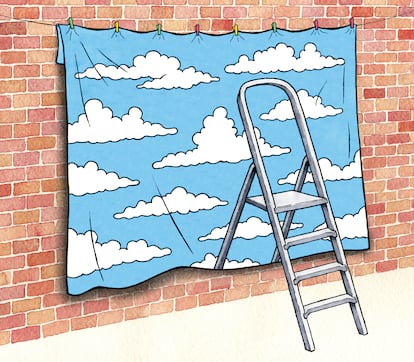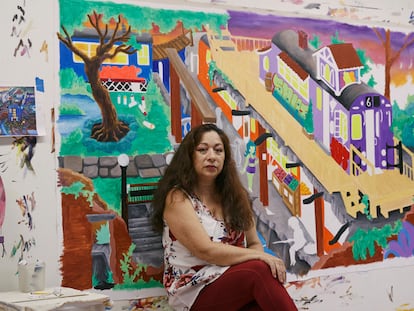Graffiti: More than writing on the wall
This urban art is a vehicle for dissidence and also has a humanist component. The product of a personal impulse, these texts and drawings are transformed into a message visible to all

When you walk down a city street, what do you see? Most of us encounter graffiti and urban art as part of our daily experience. These drawings and poetic codes break our routine patterns; they modify the scenery around us, confuse it. Often, graffiti artists seek to shock — there is something transgressive about creativity, and urban art brings it to the fore. The marginal, the unmentionable, that which only circulates as rumor and the transfiguration of the sinister are expressed to us in broad daylight, since this work is done in the public space; therein lies part of the astonishment graffiti unleashes. The street is an immense stage onto which graffiti bursts, like an unforeseen color in the city’s landscape: on train cars and other means of transportation, in tunnels, subways and public restrooms, and especially on walls. It is worth refraining from prematurely — or ideologically — judging this complex social phenomenon, in order to understand its nuances.
We tend to expect urban landscapes to be legible, but graffiti and street art destabilize and infiltrate that legibility with an alternative vision of the world, if only for a moment. They draw attention to walls: while walls serve to defend privacy and private property, graffiti transgresses them — attacks them — and, in so doing, exposes the territorial and the private. Graffiti offers a visual language to look through the wall and create imaginary spaces. This work shows us that boundaries are not really boundaries, and that border walls are rhetorical acts of security, sponsored by ideologies with particular interests. Graffiti has functioned as a tool of dissent in protests. Clearly, this art will endure; try to erase it and it will reappear.
Graffiti artists are the repositories of the fantasies, fears, anger and disillusionment of our cities. As social agents, they clandestinely deploy their strategies, sometimes risking fines, imprisonment or even their own lives by clinging to unstable sites. In 2011, Mexican artist Ana Teresa Fernández placed a huge ladder against the border wall separating Playas de Tijuana from San Diego’s Border Field State Park and, using a paint spray gun, she set about painting the bars sky blue (Fernández envisioned a world without border walls). In her imagined spaces, the steel sheets that separate the two countries disappear, and rusted bars are transfigured into a bluish sky. The border manifests itself as a powerful symbol, a site of utopian possibility. At the same time, the border wall is a reminder of violent subjugation. As Fernandez commented, “I was very happy when, late in the afternoon, a runner came from far away… and told us that for a moment he thought that part of the wall had collapsed.”
In the 1970s, graffiti was an important part of the revolutionary processes in Somoza’s Nicaragua. Omar Cabezas and Dora María Téllez — the Sandinista revolution’s heroine who is also known as Comandante Dos [Commander Two], who was recently released from a Nicaraguan prison — describe it in their book La insurrección de las paredes [Insurrection on the walls]: “We threw them out of power and out of the barracks, [but] we first evicted them from the walls... The voice of the silenced took the walls by storm.” Graffiti is one of the ways of recovering a voice, a popular and creative practice of cracking the monolithic discourses of power and institutions. “I say that the evidence [of the fact] that the people are with the revolution can be [seen] on the walls,” Téllez concludes.
In addition to its accusatory potential, graffiti can also serve as a humanist and deeply psychological project, a product of the confrontation between the human being and the wall; the signs of the forbidden, of repression, adhere to these drawings that are done impulsively and incognito, but are visible to all. According to the French-Hungarian photographer Brassaï, the unconscious manifestation of graffiti is irrefutable proof of the existence of a primitive creative force. As early as 1933, in his book From the Wall of the Caves to the Wall of the Factory, he exclaimed: “How hard is stone! How rudimentary are its instruments! What does it matter! It is no longer a question of playing, but of controlling the frenzy of the unconscious.” Brassaï finds symbols similar to the ones in Pompeii, the caves of Dordogne and the Nile valley, insinuated on walls that are a stone’s throw away from the Paris Opera. The same anguish that covered caves’ walls with a chaotic world of engravings depicting hunting, migration or procreation, today gives rise to drawings about themes specifically related to survival.
These places where walls speak and overthrow laboriously established canons enrich our movements through urban space, inviting us to pay attention to the curious, enigmatic or ideological provocations that the walls might be whispering to us.
Sign up for our weekly newsletter to get more English-language news coverage from EL PAÍS USA Edition
Tu suscripción se está usando en otro dispositivo
¿Quieres añadir otro usuario a tu suscripción?
Si continúas leyendo en este dispositivo, no se podrá leer en el otro.
FlechaTu suscripción se está usando en otro dispositivo y solo puedes acceder a EL PAÍS desde un dispositivo a la vez.
Si quieres compartir tu cuenta, cambia tu suscripción a la modalidad Premium, así podrás añadir otro usuario. Cada uno accederá con su propia cuenta de email, lo que os permitirá personalizar vuestra experiencia en EL PAÍS.
¿Tienes una suscripción de empresa? Accede aquí para contratar más cuentas.
En el caso de no saber quién está usando tu cuenta, te recomendamos cambiar tu contraseña aquí.
Si decides continuar compartiendo tu cuenta, este mensaje se mostrará en tu dispositivo y en el de la otra persona que está usando tu cuenta de forma indefinida, afectando a tu experiencia de lectura. Puedes consultar aquí los términos y condiciones de la suscripción digital.










































